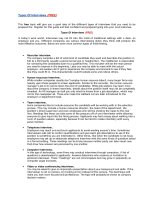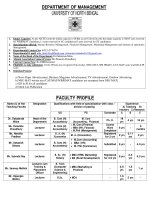TOJ VIMARU 2016 TYPES OF MANAGEMENT (1)
Bạn đang xem bản rút gọn của tài liệu. Xem và tải ngay bản đầy đủ của tài liệu tại đây (2.09 MB, 74 trang )
TYPES OF
APPROACHES
TO MANAGEMENT
Major Approaches to Management
The origins of mechanistic organization
• Instruments created to achieve other ends
– Greek: organon = tool or instrument
– Importance rose along with the industrial revolution
• “Mechanized” army
– Frederick the Great, ruled from 1740-86 – introduced rank and
uniform
– Operating through means of standardized parts
• Max Weber early twentieth century
– First definition of bureaucracy as a form of organization (precision,
speed, clarity, etc.)
Major Approaches to Management
Classical management approaches
Frederick Taylor
Scientific Management
Every job a ‘science’
Pick workers with right abilities
Carefully train and provide incentives
Support worker by planning work and removing obstacles
Says “Management is a science. There is one best way and one best person to
do the task. I love efficiency and I love to study people at work. Management
should be an academic discipline.”
His work influenced:
Bringing psychology into the workplace
Gantt Chart and planning
Harvard University offering management Degrees
6
Scientific management (cont’d)
• Time Studies
–
workers timed with stopwatches to identify “appropriate” time for specific tasks
• Motion Studies
–
workers observed to identify “one best way” of completing a task
• Theorized three basic categories of worker motivation:
1. “The Carrot”: Financial rewards for workers who perform well
2. “The Stick”: Originally tried fining workers, that failed, simply reassign them
3. “Factory Ethos”: Understanding between laborers and managers to work in harmony.
Organizational
Theory
Henry Ford
– Student of Scientific Management
Model-T Production (Highland Park:1910)
Minutes of Effort to Assemble
Late Craft
Assy Line
Fall,1913
Spring 1914
% Reduced
Engine
594
226
62
Axle
150
26.5
83
Complete
Vehicle
750
93
88
Pre-1912
20-30 per day
1913
100 per day
1914
1.000 per day
1915
3.000 per day
Taylor’s Scientific Management Principles
1. Develop a science for each element of an individual’s work,
which will replace the old rule-of-thumb method.
2. Scientifically select and then train, teach, and develop the worker.
3. Heartily cooperate with the workers so as to ensure that all work
is done in accordance with the principles of the science that has
been developed.
4. Divide work and responsibility almost equally between
management and workers. Management takes over all work for
which it is better fitted than the workers.
Henri Fayol
Management functions
Planning
Organizing
Leading
Controlling
Fayol’s 14 Principles of Management
1. Division of work
7.
Remuneration
2. Authority
8.
Centralization
3. Discipline
9.
Scalable chain
4. Unity of command
10. Order
5. Unity of direction
11. Equity
6. Subordination of
individual interests
to the general
interest
12. Stability of tenure
of personnel
13. Initiative
14. Esprit de corps
Max Weber
Bureaucracy!
Developed a theory of
authority based on an ideal
type of organization
(bureaucracy)
Emphasized rationality,
predictability, impersonality,
technical competence, and
authoritarianism
Weber’s Bureaucracy
Advantages of bureaucracy
Clear division of labor
Clear hierarchy of authority
Formal rules and procedures
Impersonality
Careers based on merit
14
Disadvantages of bureaucracy
•
•
Slowness in handling problems
Rigidity in the face of shifting needs
Resistance to change
Employee apathy
Ineffective form of organization
– Inability to achieve goals & adapt
• Red tape – excessive paperwork
– Preoccupation with the process itself
• Social dysfunctions
– Depersonalization
– Erosion of individual freedom.
15
Major Approaches to Management
Follett’s organizations as communities
Hawthorne studies
Special attention and participative leadership
increased productivity
Workers also slowed production to keep with
group norm
Kicked off human relations movement in
1950’s
McGregor’s Theory X and Theory Y
McGregor’s Theory X and Theory Y
- work sheet – self test
McGregor’s Theory X
Dislike work
Lack ambition
Are irresponsible
Resist change
Prefer to be led
Click icon to add clip art
McGregor’s Theory Y
Willing to work
Capable of self-control
Willing to accept
responsibility
Imaginative and creative
Capable of self-direction
Click icon to add clip art
McGregor’s Theory X and Theory Y
Self-fulfilling prophecies
Theory X managers create situations where
workers become dependent and reluctant
Theory Y managers create situations where
workers respond with initiative and high
performance
Argyris
Classical management principles and
practices inhibit worker maturation and are
inconsistent with the mature adult personality
Argyris
Management practices should accommodate
the mature personality by:
Increasing task responsibility
Increasing task variety
Using participative
decision making
Maslow’s Need Hierarchy Theory
• According to American psychologist Abraham Maslow, people are
motivated by unsatisfied needs.
• According to Maslow a good manager will identify which levels of need
are active for the employee to get motivated









